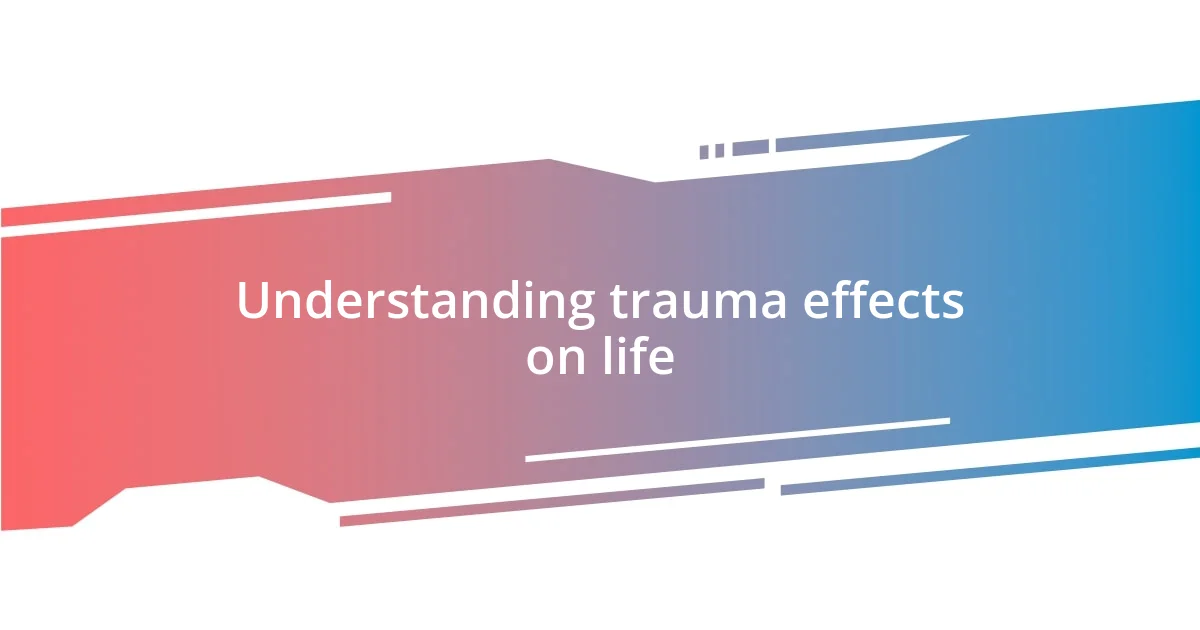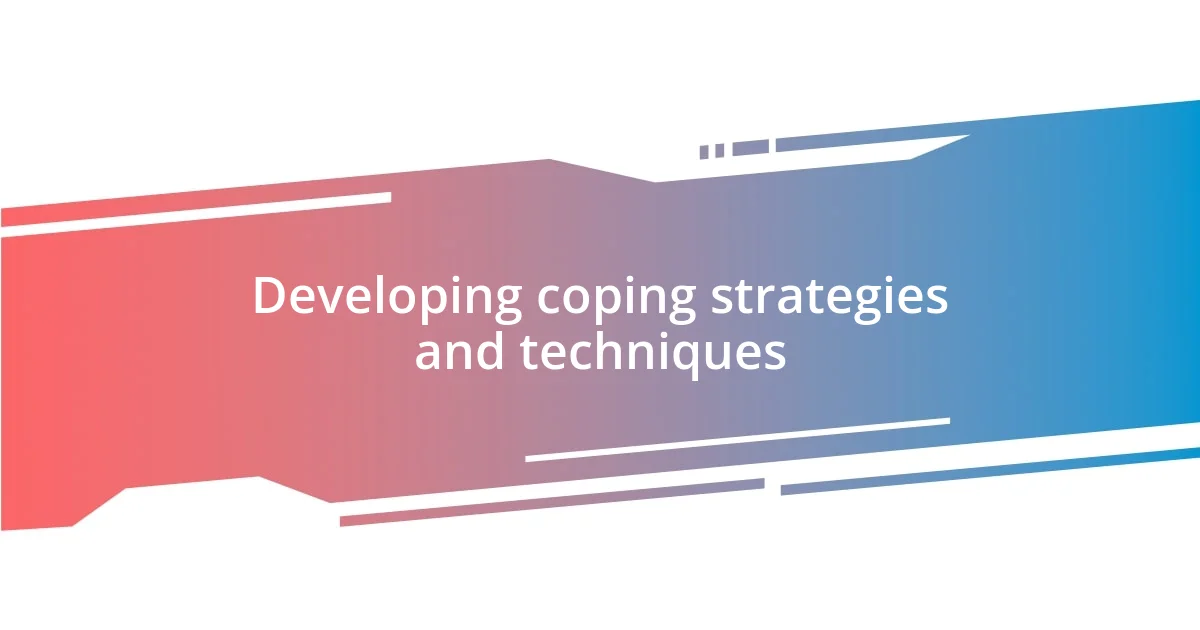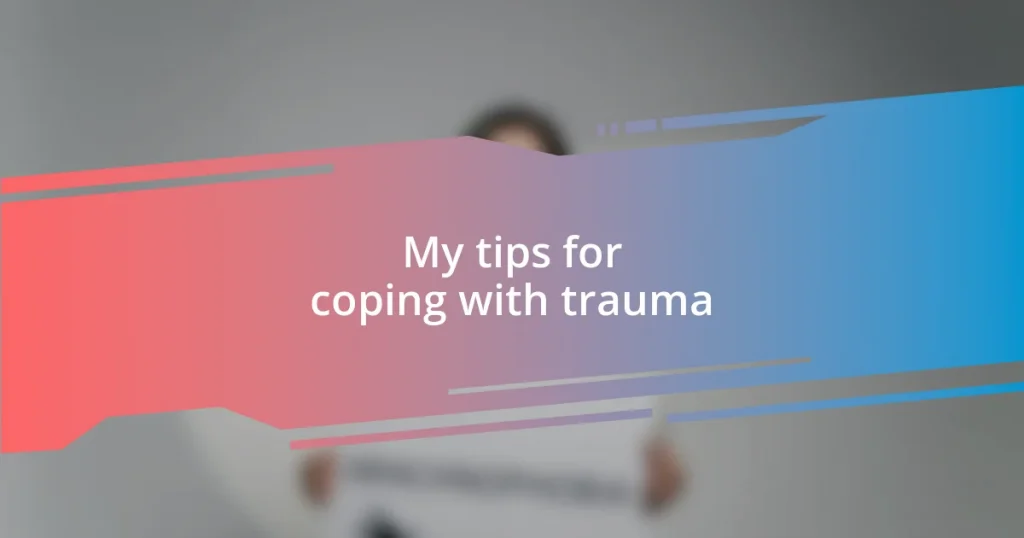Key takeaways:
- Trauma affects emotional well-being and physical health, impacting relationships and self-perception.
- Identifying personal triggers and practicing mindfulness are essential for understanding emotional responses and facilitating healing.
- Building a supportive network and engaging in therapy can significantly enhance resilience and the healing process.

Understanding trauma effects on life
Trauma can ripple through our lives in unexpected ways, leaving emotional scars that often feel invisible. I remember sitting in a crowded room once, surrounded by friends, yet feeling utterly isolated. It’s unsettling how trauma can warp your perception of safety, even in spaces meant for joy and connection.
Another aspect I find intriguing is how trauma can manifest physically. Have you ever had an unexplained ache you just couldn’t shake off? I’ve experienced this firsthand; during stressful periods, I would often find my shoulders tense and my stomach in knots. It’s astonishing how our minds and bodies are so closely linked, and understanding this connection can help us begin to heal.
The long-term effects of trauma can linger, impacting relationships and self-esteem. I recall a time when I struggled with trust after experiencing a betrayal. The hesitation to open up can create barriers that are hard to break down. It’s a journey to learn how to rebuild those bridges, but recognizing the impact of trauma is the first step towards reclaiming our lives.

Identifying personal trauma triggers
Identifying personal trauma triggers can be a vital step towards healing. I remember walking by a familiar place that brought back a rush of memories I thought I’d neatly tucked away. That sudden nostalgia hit me unexpectedly, demonstrating how certain locations can trigger emotions buried deep within. It’s important to recognize these triggers, as they often guide us to the root of our trauma.
Understanding the forms these triggers can take is also crucial. They can be as simple as a scent, a song, or even a particular tone of voice. For example, I experienced a jolt of anxiety when I heard a certain song playing on the radio that reminded me of a difficult time. Being aware of these cues allows us to prepare and create healthier coping mechanisms to face those moments instead of feeling overwhelmed.
I cannot stress enough the importance of journaling in this process. Writing down my feelings and experiences helped me connect those unsettling emotions to specific triggers. It was enlightening to see patterns emerging over time—like the way certain discussions made me feel uncomfortable. This practice has become essential for me, and I encourage others to give it a try; it can illuminate the hidden aspects of our emotional landscape.
| Types of Triggers | Examples |
|---|---|
| Emotional | Feeling anxious in crowded places |
| Environmental | Walking past a triggering location |
| Sensory | Detecting a specific fragrance or sound |

Building a support system
Building a support system can be a game changer when coping with trauma. From my experience, leaning on others helps to alleviate the heavy weight of emotional burden we sometimes carry alone. I vividly remember the relief I felt when I reached out to a close friend during a particularly difficult period. Just having someone listen, without judgment, made me feel heard and less isolated in my struggle.
To create a strong support network, consider these essential elements:
- Identify trustworthy individuals: Look for friends, family, or mentors who understand your journey.
- Communicate openly: Sharing your thoughts and feelings can foster deeper connections.
- Engage in support groups: Sometimes, connecting with those who share similar experiences can provide comfort and understanding.
- Set boundaries: It’s vital to prioritize your emotional well-being; if someone feels draining, it’s okay to step back.
- Offer support in return: Building reciprocity strengthens relationships and creates more profound bonds.
When I started participating in a local support group, I discovered a diverse community that resonated with my experiences. The relief of knowing I wasn’t alone was incredibly empowering. Sharing my story created a safe space for others, and it invigorated my healing process.

Practicing mindfulness and self-care
Practicing mindfulness has been a transformative tool for me in coping with trauma. There are moments when I find myself caught in spirals of anxiety, and during those times, I take a step back to breathe deeply. This simple act brings my focus back to the present, reminding me that while my past may feel overwhelming, it doesn’t control this moment. Have you ever noticed how just a few minutes of deep breathing can shift your perspective?
Self-care doesn’t just mean pampering yourself; it’s about nurturing your well-being on all levels. Recently, I decided to commit to a daily self-care ritual that includes not only journaling my thoughts but also indulging in long walks where I can connect with nature. I remember one particular evening when I watched the sunset, and it felt like a gentle hug from the universe. Those moments of beauty ground me and remind me that healing is a journey filled with small, powerful experiences.
Incorporating mindfulness into my daily routine was initially challenging, but the rewards have been immense. I started with just five minutes a day of meditation, and over time, it blossomed into a rich practice of self-awareness and emotional insight. In those quiet moments, I’ve often found clarity that eludes me in the chaos of daily life. Isn’t it fascinating how taking just a few moments for ourselves can help disentangle the knots of our emotions? It truly can redefine our approach to healing.

Engaging in therapy and counseling
Engaging in therapy was one of the most pivotal decisions in my healing journey. I remember my first session vividly; the apprehension mingling with a flicker of hope was palpable. It felt like stepping into a safe space where I could bare my soul without fear of judgment. Have you ever felt the weight of unspoken emotions? Talking to a professional helped me articulate feelings I didn’t even know I was holding onto, and that was a liberating experience.
Counseling offers tailored strategies that can be transformative. For instance, my therapist introduced me to cognitive-behavioral techniques, which helped me reframe negative thoughts that often clouded my mind. I distinctly recall one session when we worked through a particularly haunting memory; by the end, I felt a surprising lightness, as if a burden had been lifted. It’s eye-opening how working through trauma with a skilled guide can help us rediscover a sense of control over our lives.
Being consistently engaged in therapy provided a structure that fostered growth and introspection. I appreciated the accountability it brought—having someone who gently nudged me toward reflecting on my progress and setting realistic goals. Sometimes, I even found myself looking forward to those sessions as a time to recharge emotionally. Isn’t it amazing how sharing our stories can illuminate our paths to healing? I’ve learned that therapy isn’t just about venting; it’s a collaborative journey toward reclaiming our lives.

Developing coping strategies and techniques
One of the most effective coping strategies I’ve found is creating a personalized coping toolbox. This isn’t just any toolbox; it’s filled with techniques that resonate with me when I’m feeling overwhelmed. For example, whenever nostalgia threatens to bog me down, I reach for my “calm playlist” filled with soothing music that transports me to peaceful moments. Have you ever experienced how a single song can instantly elevate your mood? I cherish how a few familiar chords can shift my emotional state in an instant.
Additionally, I’ve learned to embrace physical activity as a powerful form of coping. Whether it’s a brisk walk or a heart-pumping workout, movement can serve as an emotional release. I recall one particularly tough day when I chose to hit the gym instead of sulking at home. By the time I finished my workout, the endorphins had kicked in, and I felt renewed energy coursing through me. Don’t you find it interesting how our bodies can help us process emotions we can’t yet articulate? That post-exercise clarity is something I actively seek out now.
Lastly, establishing a routine has been pivotal in my coping journey. When my days feel chaotic, I turn to structure as a grounding tool. On weeks when setbacks seem more prominent, I dedicate specific time slots for self-reflection, gratitude journaling, or even engaging in hobbies that bring me joy. There’s something comforting about predictability amidst uncertainty, wouldn’t you agree? It’s like wrapping yourself in a cozy blanket during a storm—each routine keeps the turbulence at bay, allowing me to navigate my emotional waters with more confidence.

Maintaining long-term resilience and healing
Certainly! Here are paragraphs to fit your request for the section on ‘Maintaining long-term resilience and healing’:
Whenever I think about long-term resilience, I can’t help but appreciate the importance of community. Surrounding myself with supportive friends and family has been invaluable; their empathy served as a grounding force when my emotions threatened to overwhelm me. I recall a weekend gathering where I shared my struggles, and rather than judgment, I was met with understanding. Have you ever felt that instant relief when someone simply listens? It’s those moments of connection that strengthen our ability to heal.
In my journey, I’ve discovered the significance of self-compassion. Initially, I struggled with being gentle on myself during difficult moments; I often thought I should be “over it” by now. One day, as I sat outside feeling defeated, it hit me—I wouldn’t speak to a friend that way. Embracing self-kindness transformed my internal dialogue, allowing space for healing instead of guilt. Isn’t it fascinating how the way we treat ourselves can either hinder or bolster our recovery?
Lastly, I’ve realized that embracing change is crucial for maintaining resilience over time. Not every day will be perfect, and that’s okay. For instance, I experienced a setback when an old trigger resurfaced unexpectedly. Instead of spiraling, I reminded myself that growth isn’t linear; it’s about learning and adapting. When was the last time you found strength in vulnerability? I found that each challenge offered invaluable lessons that not only enriched my healing process but also fostered a deeper understanding of myself.













